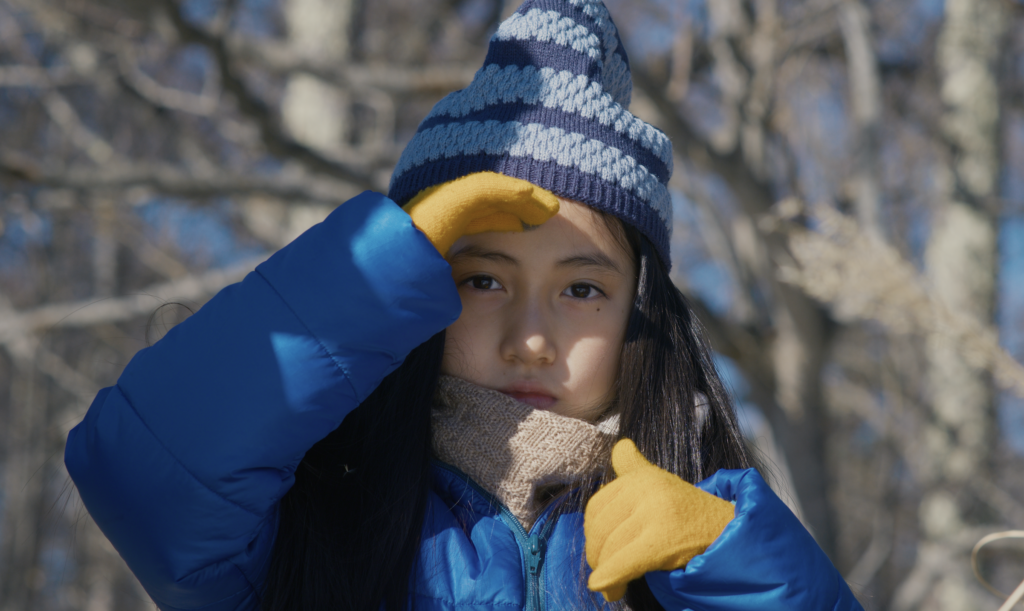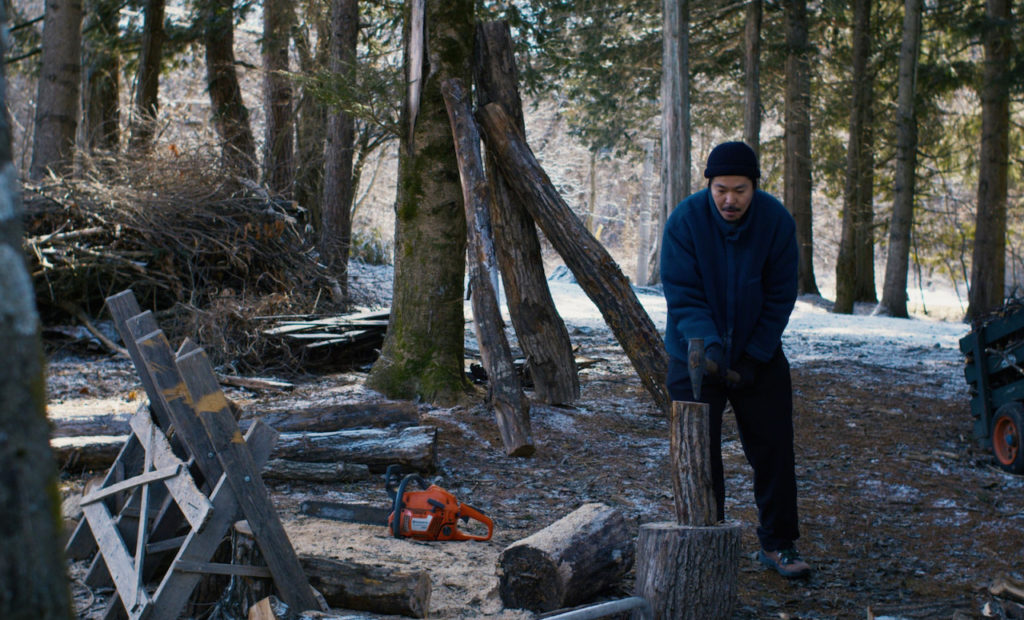Director: Ryûsuke Hamaguchi
Writers: Ryûsuke Hamaguchi, Eiko Ishibashi
Stars: Hitoshi Omika, Ryô Nishikawa, Ryûji Kosaka
Synopsis: Takumi and his daughter Hana live in Mizubiki Village, close to Tokyo. One day, the village inhabitants become aware of a plan to build a camping site near Takumi’s house offering city residents a comfortable “escape” to nature.
It took Ryûsuke Hamaguchi around 40 minutes before he dropped the title card in his 2021 Oscar-winning film Drive My Car. A magnificent film regardless of that type of specific heat check, the renowned Japanese director seems particularly aware of how his next film might be perceived. In that case, he sheds any notion of playfulness by opening the film with the title card at frame one: Evil Does Not Exist. And as soon as that’s out of the way, Hamaguchi offers his hand to his audience to guide them somewhat aimlessly through a forest. Lush trees slowly creep in and out of the frame as we look skyward, unsure of where we are, how we got there, where we’re going; but it’s soothing, especially when treated to the rich score of Eiko Ishibashi, which will most certainly be a talking point for audiences after the film. But over time, as the credits interject themselves into the serene images of greenery, the leaves are replaced with empty branches and decay. Now, this could be due in part to the time of year, but if there’s anything about Hamaguchi’s films that become immediately clear, it’s that every image is clearly calculated to invoke a thought or emotion in the viewer. And within mere minutes, the standard act of letting credits roll becomes a thesis statement in its own right. There’s nature, there’s the people that inhabit nature, and there’s the people who invade it.

Takumi (Hitoshi Omika) lives in Mizubiki, a small village an hour or two from Tokyo. Hamaguchi introduces him rather silently. With that, over the course of a few scenes, we begin to get a sense of his routine and person. With little emotion, he chops wood efficiently and serenely gathers fresh water. It’s only upon his friend arriving to help carry the several gallons of water back to the car that he says anything. After a short interaction that captures the kind of person Takumi is, as well as his clear knowledge of the surrounding flora, he’s off to pick up his daughter, Hana. There’s a lot of driving in this film, and for a filmmaker like Hamaguchi, who often keeps the camera still and slow, he makes such an interesting choice when using vehicles. There are multiple sequences of the film wherein the camera appears to be set up in the trunk, looking out behind the car. It mimics a rear view camera, which we also see during one extended sequence, but to a much greater scale. It shakes with the opening and closing of a car door, rocks as the vehicle goes over gravel, and captures the sounds of nearby pedestrians and turning signals. As easily as Hamaguchi is able to transport us to the calm beauty of the outdoors, he can just as easily place us in the claustrophobia of a trunk. It’s this style of engrossing direction that Hamaguchi is able to excel at.
One of the most noticeable elements of Evil Does Not Exist is the ways in which the camera ever so subtly lingers. In most instances where a character exits the frame, Hamaguchi holds in serenity. It’s a reminder that the nature we find ourselves in on a consistent basis exists outside of us. We as people are not simply living on the land, but rather, we are living alongside it. Just because a character leaves Mizubiki to venture back into the city doesn’t mean that the hamlet or the surrounding woods freezes. It exists far beyond the scope of what these encroaching outsiders can imagine. It is in this infinite beauty, or rather, the desperation to protect and preserve it, wherein Hamaguchi is able to mine the emotional depths of his latest film.
The residents of Mizubiki convene at a meeting in which a company is laying out their plans for a new glamping resort. The forum is taking place in order for the residents to state their concerns or pose any questions regarding the resort. And it doesn’t take long before both the viewer and the residents of Mizubiki realize what’s occurring. This forum is basically for show. The two representatives attending are just talent agents, who, in their words, are “not qualified to reply” to certain statements being made. It’s a deeply frustrating experience exacerbated only by the fact that we know the outcome of this forum is already written in the profit margins of a spreadsheet. These representatives can take all the notes and feedback they’d like, from community criticisms to constructive, thought-out personal statements alike. But upon bringing it to upper management, the notion of cost comes up without hesitation. Damn the environment they’re encroaching upon and all who live nearby. In the eyes of the company president, a small enough pollution within the necessary legal parameters isn’t worth the loss of any possible profits. To put one of the more eloquent and thoughtful monologues of the film into more blunt, matter-of-fact terms, sh*t always rolls downhill. Whether it’s the literal overflow of a septic tank from the glamping resort, or upper management basically instructing employees to tell the village residents to piss off, the company was not there to listen; they were merely there to look better to local authorities and to proclaim what will be happening. It’s an anger-inducing sequence, reminiscent of Todd Haynes’ masterful Dark Waters, another film interested in the ways in which corporate greed and business jargon are used to destroy local communities and the very ground beneath our feet.

One can’t help but think of the title of this film in relation to a scene that occurs shortly after a request for a second forum is made. Takumi is discussing whether or not local deer will bite glamping residents. He assures them that they are docile and tend to avoid humans, unless they’ve been shot by hunters and can no longer run. Instead, they will stand and brace for an attack if they must. It’s here that Hamaguchi’s grand title feels as if it takes some shape. In this reading, evil does not exist naturally, but instead, it is created. It’s born out of desperation, brought on by the nature of human greed. To fault a gut shot deer for standing its ground in adrenaline-fueled fear and defense would be illogical. And the same logic should be given to both the earth itself, but also to the people who defend it. In this case, it’s the residents of Mizubiki. You can only remain quiet and inquisitive so long before realizing that there’s only a single path ahead.
In its first two acts, Hamaguchi’s Evil Does Not Exist leaves you with much to contemplate. It’s a patient film that rewards its audience with an enriching world and set of ideas. Even so, this feels far more direct than Hamaguchi’s approach in Drive My Car. Take, for example, a sequence in the final act of this film. It mirrors an earlier sequence, only this time, there has been a fundamental shift. It’s a disorientingly scary one, and is best experienced wholly in the moment. Hamaguchi once again leaves us with a coda to rack our brain, but not with the intention of being mysterious for the sake of shock. Instead, he and his films innately understand that life is hardly ever made up of two paths. There are many, and in many cases, it’s hard to tell which is the right one and which is the wrong one to take.





